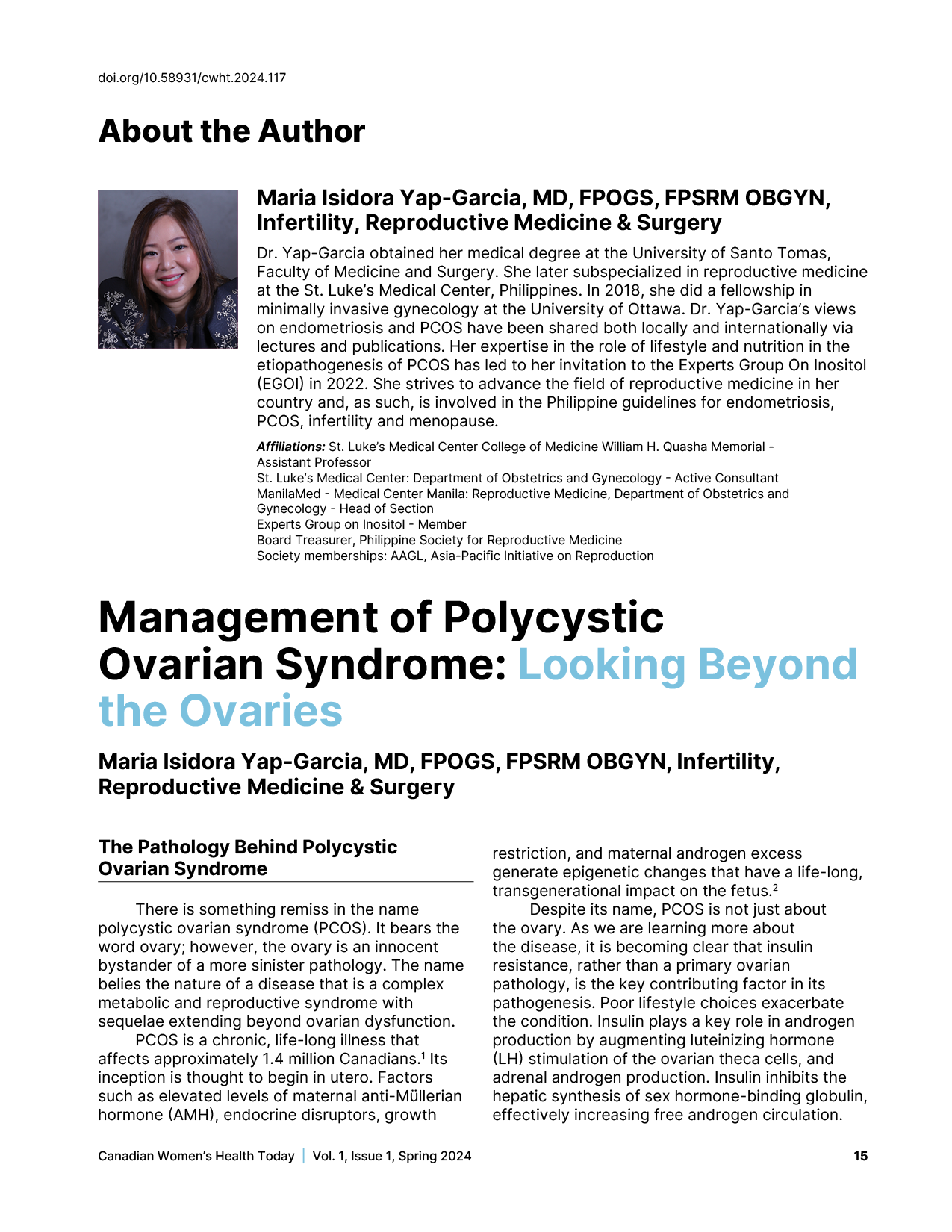Management of Polycystic Ovarian Syndrome: Looking Beyond the Ovaries
DOI:
https://doi.org/10.58931/cwht.2024.117Abstract
There is something remiss in the name polycystic ovarian syndrome (PCOS). It bears the word ovary; however, the ovary is an innocent bystander of a more sinister pathology. The name belies the nature of a disease that is a complex metabolic and reproductive syndrome with sequelae extending beyond ovarian dysfunction.
PCOS is a chronic, life-long illness that affects approximately 1.4 million Canadians. Its inception is thought to begin in utero. Factors such as elevated levels of maternal anti‑Müllerian hormone (AMH), endocrine disruptors, growth restriction, and maternal androgen excess generate epigenetic changes that have a life-long, transgenerational impact on the fetus.
References
Lujan ME, Chizen DR, Pierson RA. Diagnostic criteria for polycystic ovary syndrome: pitfalls and controversies. J Obstet Gynaecol Can. 2008 Aug;30(8):671-679. doi: 10.1016/S1701-2163(16)32915-2.
Sanchez-Garrido MA, Tena-Sempere M. Metabolic dysfunction in polycystic ovary syndrome: pathogenic role of androgen excess and potential therapeutic strategies. Mol Metab. 2020 May;35:100937.
McCartney CR, Marshall JC. Clinical practice. polycystic ovary syndrome. N Engl J Med. 2016 Jul 7;375(1):54‑64.
Teede HJ, Tay CT, Laven J, Dokras A, Moran LJ, Piltonen TT, et al. Recommendations from the 2023 International Evidence-based Guideline for the Assessment and Management of Polycystic Ovary Syndrome†. Hum Reprod. 2023 Sep 5;38(9):1655-1679. doi: 10.1093/humrep/dead156.
Carmina E, Azziz R, Bergfeld W, Escobar-Morreale HF, Futterweit W, Huddleston H, et al. Female pattern hair loss and androgen excess: a report from the Multidisciplinary Androgen Excess and PCOS Committee. J Clin Endocrinol Metab. 2019 Jul 1;104(7):2875-2891. doi: 10.1210/jc.2018-02548.
Butt MS, Saleem J, Aiman S, Zakar R, Sadique I, Fischer F. Serum anti-Müllerian hormone as a predictor of polycystic ovarian syndrome among women of reproductive age. BMC Womens Health. 2022 May 28;22(1):199. doi: 10.1186/s12905-022-01782-2.
Bergman RN. Orchestration of glucose homeostasis: from a small acorn to the California oak. Diabetes. 2007 Jun;56(6):1489-501. doi: 10.2337/db07-9903.
Andersen M, Glintborg D. Diagnosis and follow-up of type 2 diabetes in women with PCOS: a role for OGTT? Eur J Endocrinol. 2018 Sep;179(3):D1-D14. doi: 10.1530/EJE-18-0237. Epub 2018 Jun 19.
Noel M, Kao CN, Cedars MI, Huddleston HG. Predictive value of fasting insulin on metabolic parameters in polycystic ovarian syndrome patients with normal fasting glucose. Fert Stert. 2014 Sep 102(3): e28. doi: 10.1016/j.fertstert.2014.07102. DOI
Auclair MH, Yong PJ, Salvador S, Thurston J, Colgan TTJ, Sebastianelli A. Guideline No. 390-Classification and Management of Endometrial Hyperplasia. J Obstet Gynaecol Can. 2019 Dec;41(12):1789-1800. doi: 10.1016/j.jogc.2019.03.025. Erratum in: J Obstet Gynaecol Can. 2020 Oct;42(10):1287.
Parker J, O’Brien C, Hawrelak J, Gersh FL. Polycystic ovary syndrome: an evolutionary adaptation to lifestyle and the environment. Int J Environ Res Public Health. 2022 Jan 25;19(3):1336. doi: 10.3390/ijerph19031336.
Haqq L, McFarlane J, Dieberg G, Smart N. Effect of lifestyle intervention on the reproductive endocrine profile in women with polycystic ovarian syndrome: a systematic review and meta-analysis. Endocr Connect. 2014 Feb 28;3(1):36-46. doi: 10.1530/EC-14-0010.
Armanini D, Boscaro M, Bordin L, Sabbadin C. Controversies in the pathogenesis, diagnosis and treatment of PCOS: focus on insulin resistance, inflammation, and hyperandrogenism. Int J Mol Sci. 2022 Apr 8;23(8):4110. doi: 10.3390/ijms23084110.
Pernicova I, Korbonits M. Metformin--mode of action and clinical implications for diabetes and cancer. Nat Rev Endocrinol. 2014 Mar;10(3):143-56. doi: 10.1038/nrendo.2013.256. Epub 2014 Jan 7.
Xu Y, Wu Y, Huang Q. Comparison of the effect between pioglitazone and metformin in treating patients with PCOS:a meta-analysis. Arch Gynecol Obstet. 2017 Oct;296(4):661-677. doi: 10.1007/s00404-017-4480-z.
Franik S, Le QK, Kremer JA, Kiesel L, Farquhar C. Aromatase inhibitors (letrozole) for ovulation induction in infertile women with polycystic ovary syndrome. Cochrane Database Syst Rev. 2022 Sep 27;9(9):CD010287. doi: 10.1002/14651858.CD010287.pub4.
Unfer V, Porcaro G. Updates on the myo-inositol plus D-chiro-inositol combined therapy in polycystic ovary syndrome. Expert Rev Clin Pharmacol. 2014 Sep;7(5):623-31. doi: 10.1586/17512433.2014.925795.
Kamenov Z, Gateva A. Inositols in PCOS. Molecules. 2020 Nov 27;25(23):5566. doi: 10.3390/molecules25235566.
Chiu TT, Rogers MS, Law EL, Briton-Jones CM, Cheung LP, Haines CJ. Follicular fluid and serum concentrations of myo-inositol in patients undergoing IVF: relationship with oocyte quality. Hum Reprod. 2002 Jun;17(6):1591-6. doi: 10.1093/humrep/17.6.1591.
Papaleo E, Unfer V, Baillargeon JP, Fusi F, Occhi F, De Santis L. Myo-inositol may improve oocyte quality in intracytoplasmic sperm injection cycles. A prospective, controlled, randomized trial. Fertil Steril. 2009 May;91(5):1750-4. doi: 10.1016/j.fertnstert.2008.01.088
Zheng X, Lin D, Zhang Y, Lin Y, Song J, Li S, et al. Inositol supplement improves clinical pregnancy rate in infertile women undergoing ovulation induction for ICSI or IVF-ET. Medicine (Baltimore). 2017 Dec;96(49):e8842. doi: 10.1097/MD.0000000000008842
Wang H, Li N, Chivese T, Werfalli M, Sun H, Yuen L, et al. IDF Diabetes atlas: estimation of global and regional gestational diabetes mellitus prevalence for 2021 by International Association of Diabetes in Pregnancy Study Group’s Criteria. Diabetes Res Clin Pract. 2022 Jan;183:109050. doi: 10.1016/j.diabres.2021.109050.
D’Anna R, Santamaria A, Alibrandi A, Corrado F, DI Benedetto A, Facchinetti F. Myo-inositol for the prevention of gestational diabetes mellitus. a brief review. J Nutr Sci Vitaminol (Tokyo). 2019;65(Supplement):S59-S61. doi: 10.3177/jnsv.65.S59.

